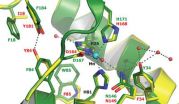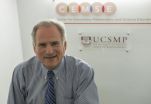(Press-News.org) Scientists have confirmed that the pathogen that causes Lyme Disease—unlike any other known organism—can exist without iron, a metal that all other life needs to make proteins and enzymes. Instead of iron, the bacteria substitute manganese to make an essential enzyme, thus eluding immune system defenses that protect the body by starving pathogens of iron.
To cause disease, Borrelia burgdorferi requires unusually high levels of manganese, scientists at Johns Hopkins University (JHU), Woods Hole Oceanographic Institution (WHOI), and the University of Texas reported. Their study, published March 22, 2013, in the Journal of Biological Chemistry, may explain some mysteries about why Lyme Disease is slow-growing and hard to detect and treat. The findings also open the door to search for new therapies to thwart the bacterium by targeting manganese.
"When we become infected with pathogens, from tuberculosis to yeast infections, the body has natural immunological responses," said Valeria Culotta, a molecular biologist at the JHU Bloomberg School of Public Health. The liver produces hepcidin, a hormone that inhibits iron from being absorbed in the gut and also prevents it from getting into the bloodstream. "We become anemic, which is one reason we feel terrible, but it effectively starves pathogens of iron they need to grow and survive," she said.
Borrelia, with no need for iron,has evolved to evade that defense mechanism. In 2000, groundbreaking research on Borrelia's genome by James Posey and Frank Gherardini at the University of Georgia showed that the bacterium has no genes that code to make iron-containing proteins and typically do not accumulate any detectable iron.
Culotta's lab at JHU investigates what she called "metal-trafficking" in organisms—the biochemical mechanisms that cells and pathogens such as Borrelia use to acquire and manipulate metal ions for their biological purposes.
"If Borrelia doesn't use iron, what does it use?" Culotta asked.
To find out, Culotta's lab joined forces with Mak Saito, a marine chemist at WHOI, who had developed techniques to explore how marine life uses metals. Saito was particularly intrigued because of the high incidence of Lyme Disease on Cape Cod, where WHOI is located, and because he specializes in metalloproteins, which contain iron, zinc, cobalt, and other elements often seen in vitamin supplements. The metals serve as linchpins, binding to enzymes. They help determine the enzymes' distinctive three-dimensional shapes and the specific chemical reactions they catalyze.
It's difficult to identify what metals are within proteins because typical analyses break apart proteins, often separating metal from protein. Saito used a liquid chromatography mass spectrometer to distinguish and measure separate individual Borrelia proteins according to their chemical properties and infinitesimal differences in their masses. Then he used an inductively coupled plasma mass spectrometer to detect and measure metals down to parts per trillion. Together, the combined analyses not only measured the amounts of metals and proteins, they showed that the metals are components of the proteins.
"The tools he has are fantastic," Culotta said. "Not too many people have this set of tools to detect metalloproteins."
The experiments revealed that instead of iron, Borrelia uses that element's next-door neighbor on the periodic chart, manganese, in certain Borrelia enzymes. These include an amino peptidase and an important antioxidant enzyme called superoxide dismutase.
Superoxide dismutase protects the pathogens against a second defense mechanism that the body throws against them. The body bombards pathogens with superoxide radicals, highly reactive molecules that cause damage within the pathogens. Superoxide dismutase is like an antioxidant that neutralizes the superoxides so that the pathogens can continue to grow.
The discoveries open new possibilities for therapies, Culotta said. "The only therapy for Lyme Disease right now are antibiotics like penicillin, which are effective if the disease is detected early enough. It works by attacking the bacteria's cell walls. But certain forms of Borrelia, such as the L-form, can be resistant because they are deficient in cell walls."
"So we'd like to find targets inside pathogenic cell that could thwart their growth," she continued. "The best targets are enzymes that the pathogens have, but people do not, so they would kill the pathogens but not harm people." Borrelia's distinctive manganese-containing enzymes such as superoxide dismutase may have such attributes.
In search of new avenues of attack, the groups are planning to expand their collaborative efforts by mapping out all the metal-binding proteins that Borellia uses and investigating biochemical mechanisms that the bacteria use to acquire manganese and directs it into essential enzymes. Knowing details of how that happens offers ways to disrupt the process and deter Lyme Disease.
INFORMATION:
The authors of the new study are J. Daphne Aguirre, Hillary Clark, Christine Vazquez, Shaina Palmere, and Culotta (JHU Bloomberg School of Public Health); Saito and Matthew McIlvin (WHOI); Denise Grab (JHS School of Medicine); Janakiram Seshu (University of Texas); and P. John Hart (University of Texas Health Science Center).
This research was funded by the National Institutes of Health, the National Science Foundation, and the Gordon and Betty Moore Foundation.
Scientists reveal quirky feature of Lyme disease bacteria
Unlike most organisms, they don't need iron, but they crave manganese
2013-03-22
ELSE PRESS RELEASES FROM THIS DATE:
New ASTRO white paper recommends peer review to increase quality assurance and safety
2013-03-22
The American Society for Radiation Oncology (ASTRO) has issued a new white paper, "Enhancing the role of case-oriented peer review to improve quality and safety in radiation oncology: Executive Summary," that recommends increased peer review within the radiation therapy treatment process and among members of the radiation oncology team in order to increase quality assurance and safety, according to the manuscript published as an article in press online in Practical Radiation Oncology (PRO), the official clinical practice journal of ASTRO. The executive summary and supplemental ...
Prescription for double-dose algebra proves effective
2013-03-22
Martin Gartzman sat in his dentist's waiting room last fall when he read a study in Education Next that nearly brought him to tears.
A decade ago, in his former position as chief math and science officer for Chicago Public Schools, Gartzman spearheaded an attempt to decrease ninth-grade algebra failure rates, an issue he calls "an incredibly vexing problem." His idea was to provide extra time for struggling students by having them take two consecutive periods of algebra.
Gartzman had been under the impression that the double-dose algebra program he had instituted had ...
Research explores links between physical and emotional pain relief
2013-03-22
Though we all desire relief -- from stress, work, or pain -- little is known about the specific emotions underlying relief. New research from the Association for Psychological Science explores the psychological mechanisms associated with relief that occurs after the removal of pain, also known as pain offset relief.
This new research shows that healthy individuals and individuals with a history of self-harm display similar levels of relief when pain is removed, which suggests that pain offset relief may be a natural mechanism that helps us to regulate our emotions.
Feeling ...
A closer look at LDCM's first scene
2013-03-22
Turning on new satellite instruments is like opening new eyes. This week, the Landsat Data Continuity Mission (LDCM) released its first images of Earth, collected at 1:40 p.m. EDT on March 18. The first image shows the meeting of the Great Plains with the Front Ranges of the Rocky Mountains in Wyoming and Colorado. The natural-color image shows the green coniferous forest of the mountains coming down to the dormant brown plains. The cities of Cheyenne, Fort Collins, Loveland, Longmont, Boulder and Denver string out from north to south. Popcorn clouds dot the plains while ...
Stayin' alive -- delivering resuscitation messages to the public
2013-03-22
Teaching bystander Cardiac Pulmonary Resuscitation (CPR) strategically to the general public offers the greatest potential to make the biggest overall impact on survival in out of hospital cardiac arrests in Europe, reported a main session on Resuscitation Science at the European Society of Cardiology's EuroHeart Care Congress, which took place in Glasgow, 22 to 23 March, 2013.
"The reality is that four out of five cardiac arrests happen at home, and unless the public are trained in resuscitation many people die before emergency services get to them," said Mary Hannon. ...
Complementary and alternative medicine studies take center stage at EuroHeart Care
2013-03-22
Yoga and acupressure could both play an important role in helping patients with atrial fibrillation (AF). Two abstracts presented at the at the European Society of Cardiology's EuroHeart Care Congress, which takes place in Glasgow, 22 to 23 March, 2013, show the potential for medical yoga¹ and acupressure², in addition to pharmacological therapies, to reduce blood pressure and heart rates in patients with AF. In a third abstract³, a survey found that complementary and alternative therapies (CATs), were widely used by patients attending cardiology clinics, raising concerns ...
Prevention of heart disease requires professionals to go out into communities
2013-03-22
Deprivation represents the "elephant in the room" with regard to cardiovascular disease (CVD), and health care professionals have an important role to play in tackling the problem, delegates heard at a special plenary session opening the EuroHeart Care Congress in Glasgow, Scotland, 22 March to 23 March 2013. The session heard how Scotland, a country considered to have the highest rates of heart disease in Western Europe, has recently taken action to address the CVD health inequalities that exist between affluent and deprived communities.
Mr Michael Matheson, the Public ...
Smoking affects fracture healing
2013-03-22
CHICAGO – In a new study presented today at the 2013 Annual Meeting of the American Academy of Orthopaedic Surgeons (AAOS), researchers reviewed existing literature on smoking and the healing of fractures involving long bones (bones that are longer than they are wide).
The analysis of data from 20 studies found an overall 2.3 times higher risk of nonunion (bones that do not heal properly) in smokers. Similarly, for all fractures, the average time to fracture healing was longer for smokers (32 weeks) than nonsmokers (25.1 weeks).
The review illustrates the effects ...
Hip replacement reduces heart failure, depression and diabetes risk
2013-03-22
CHICAGO — In addition to improving life quality and diminishing pain, total hip replacement (THR) is associated with reduced mortality, heart failure, depression and diabetes rates in Medicare patients with osteoarthritis, according to a new study presented today at the 2013 Annual Meeting of the American Academy of Orthopaedic Surgeons (AAOS). The procedure also is cost effective with the 7-year costs of THR only $6,366 higher than the cost of treating an osteoarthritis patient for hip pain without THR.
"The study has demonstrated that THR confers a potential long-term ...
Study highlights variations in spinal component costs
2013-03-22
CHICAGO – In a study, presented today at the 2013 Annual Meeting of the American Academy of Orthopaedic Surgeons (AAOS), researchers obtained and compared the hospital purchasing records from 45 academic medical centers on the unit costs and volume of spinal products – pedicle screws (PS), anterior cervical plates (ACP) and posterior interbody cages – purchased from a total of seven vendors.
Among the results:
PS had a mean cost of $878, with a range of $400 to $1,843 per patient;
ACP had a mean cost of $1,068, with a range of $540 to $2,388; and,
cages, $2,975, ...
LAST 30 PRESS RELEASES:
Making lighter work of calculating fluid and heat flow
Normalizing blood sugar can halve heart attack risk
Lowering blood sugar cuts heart attack risk in people with prediabetes
Study links genetic variants to risk of blinding eye disease in premature infants
Non-opioid ‘pain sponge’ therapy halts cartilage degeneration and relieves chronic pain
AI can pick up cultural values by mimicking how kids learn
China’s ecological redlines offer fast track to 30 x 30 global conservation goal
Invisible indoor threats: emerging household contaminants and their growing risks to human health
Adding antibody treatment to chemo boosts outcomes for children with rare cancer
Germline pathogenic variants among women without a history of breast cancer
Tanning beds triple melanoma risk, potentially causing broad DNA damage
Unique bond identified as key to viral infection speed
Indoor tanning makes youthful skin much older on a genetic level
Mouse model sheds new light on the causes and potential solutions to human GI problems linked to muscular dystrophy
The Journal of Nuclear Medicine ahead-of-print tip sheet: December 12, 2025
Smarter tools for peering into the microscopic world
Applications open for funding to conduct research in the Kinsey Institute archives
Global measure underestimates the severity of food insecurity
Child survivors of critical illness are missing out on timely follow up care
Risk-based vs annual breast cancer screening / the WISDOM randomized clinical trial
University of Toronto launches Electric Vehicle Innovation Ontario to accelerate advanced EV technologies and build Canada’s innovation advantage
Early relapse predicts poor outcomes in aggressive blood cancer
American College of Lifestyle Medicine applauds two CMS models aligned with lifestyle medicine practice and reimbursement
Clinical trial finds cannabis use not a barrier to quitting nicotine vaping
Supplemental nutrition assistance program policies and food insecurity
Switching immune cells to “night mode” could limit damage after a heart attack, study suggests
URI-based Global RIghts Project report spotlights continued troubling trends in worldwide inhumane treatment
Neutrophils are less aggressive at night, explaining why nighttime heart attacks cause less damage than daytime events
Menopausal hormone therapy may not pose breast cancer risk for women with BRCA mutations
Mobile health tool may improve quality of life for adolescent and young adult breast cancer survivors
[Press-News.org] Scientists reveal quirky feature of Lyme disease bacteriaUnlike most organisms, they don't need iron, but they crave manganese


